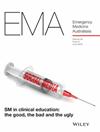Atrial fibrillation patients presenting to an emergency department successfully managed with a next-day community follow-up pathway: A before-and-after cohort study
Abstract
Objectives
To assess the effectiveness and safety of the new clinical pathway for patients presenting to an ED with AF, incorporating community next-working-day follow-up and more specific clinician guidance around medication prescribing.
Methods
A before-and-after, retrospective cohort study comparing patients presenting to Christchurch ED with acute uncomplicated AF in the year before (‘hospital-based’ follow-up) and after (‘community-based’ follow-up) implementation of a new AF management approach. The ‘community’ pathway replaced hospital-based review with a next-day community follow-up and introduced more specific anticoagulation recommendations.
Results
A total of 1065 patients met inclusion criteria, with 531 presenting during the ‘hospital-based’ pathway period and 534 during the ‘community’ pathway period. The spontaneous reversion rate was approximately 61% in both cohorts. Following the implementation of the community pathway, there was no increase in cardioversions (16.6% vs 20%, difference 3.5% [95% CI −1.4 to 8.3]), admission rates (32.8% vs 32.2%, difference − 0.6% [95% CI −6.4 to 5.3]), or AEs (60-day all-cause mortality 1.3% vs 0.9%, difference − 0.7% [95% CI −2.3 to 1]). Attendance at a follow-up AF clinic improved from 92.9% to 98.1% (difference 5.2% [95% CI 0.7–9.7]). Clinician adherence to anticoagulation guidelines increased by 7% (95% CI 1.6–12.4).
Conclusions
A ‘rate-and-wait’ strategy for managing acute uncomplicated AF continues to allow a significant proportion of patients to self-revert to sinus rhythm, without requiring hospital admission or cardioversion procedures. Transitioning to an off-site, community AF clinic is both safe and effective, demonstrating increased clinic attendance and improved adherence to anticoagulation guidelines.


 求助内容:
求助内容: 应助结果提醒方式:
应助结果提醒方式:


